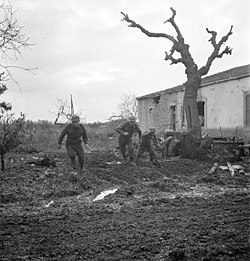| Moro River campaign | |||||||
|---|---|---|---|---|---|---|---|
| Part of the Winter Line and the battle for Rome of the Italian campaign, World War II | |||||||
 Riflemen of the 48th Highlanders of Canada take cover during German counterattack north of San Leonardo, 10 December 1943. | |||||||
| |||||||
| Belligerents | |||||||
|
|
| ||||||
| Commanders and leaders | |||||||
|
|
| ||||||
| Strength | |||||||
|
4 Infantry Divisions 2 Armoured Brigades |
1 Panzer Division 1 Parachute Division 2 Panzergrenadier Divisions | ||||||
| Casualties and losses | |||||||
|
| Unknown | ||||||
The Moro River campaign was an important battle of the Italian campaign during the Second World War, fought between elements of the British Eighth Army and LXXVI Panzer Corps (LXXVI Panzerkorps) of the German 10th Army (10. Armee). Lasting from 4 December 1943 to 4 January 1944, the campaign occurred primarily in the vicinity of the Moro River in eastern Italy. The campaign was designed as part of an offensive launched by General Sir Harold Alexander's Allied 15th Army Group, with the intention of breaching the German Army's Winter Line defensive system and advancing to Pescara—and eventually Rome.
Beginning on 4 December, four infantry divisions—one British, one Canadian, one Indian and one New Zealand (which included an armoured brigade)—and two armoured brigades (one British and one Canadian) of V Corps and XIII Corps attacked heavily defended German positions along the Moro River, achieving several exploitable bridgeheads by 8 December. Throughout the next week, nearly continuous combat operations by both sides—designed to keep one another pinned down—created stagnated defensive positions near Orsogna and a narrow pit known as "The Gully". After being held at the Gully for 10 days, the Canadians succeeded in outflanking German defences, and forcing a German withdrawal to the Ortona–Orsogna Line. On 20 December, the line was attacked by both corps.
By 26 December, strong German defences had stalled Canadian forces during the Battle of Ortona and British and New Zealand forces in Orsogna. Although both Ortona and Villa Grande were captured by the end of December, general exhaustion among the Allied forces prevented the capture of Orsogna and an advance to Pescara. When harsh winter weather set in, it became clear to the Allied commanders that no further progress would be made and General Alexander called off the offensive.
Cite error: There are <ref group=nb> tags on this page, but the references will not show without a {{reflist|group=nb}} template (see the help page).